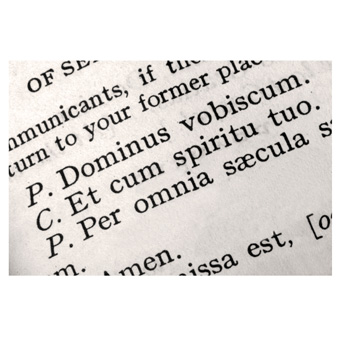How did we arrive at this translation of the Mass?
As Catholics in the United States get accustomed to new responses and prayers at Sunday Mass, many will probably ask: Why did the Mass change? The answers have to do with changes to the Latin text upon which the English translation is based and on the rules according to which the translations are made.
When the bishops at the Second Vatican Council decided that at least parts of the liturgy should be in the language of the people, they determined that national groups (“conferences”) of bishops should prepare translations of the Latin texts in the vernacular. Because English is widely used throughout the world, bishops from English-speaking countries created one translation group, the International Commission on English in the Liturgy (ICEL), which gathered translators, poets, biblical scholars, and others to produce the English texts of the Mass and other sacraments.
ICEL was guided by a 1969 instruction from the Consilium, the Vatican commission in charge of implementing the liturgical reform. This document, Comme le prevoit, gave translators the freedom to adapt the translation of the Latin text so that its meaning would be clearer in the vernacular. So, for example, the response of the people to the priest, “Et cum spiritu tuo,” which literally means “And with your spirit,” became “And also with you,” which has the same meaning as the Latin (if not the exact wording) but is more straightforward in modern English.
The first full revised Latin texts of the Mass after the Second Vatican Council were released in 1969. ICEL released its first full English translation in 1970; that English text was used with minor changes until November of this year. In 1983 ICEL began work on a second English translation of the Mass, based on a 1975 second edition of the Latin texts, in the hopes of producing a more poetic English translation. That version was approved by all the English-speaking conferences of bishops and sent to Rome in 1998.
In 2001, however, the Vatican Congregation for Divine Worship issued a new instruction on translation, Liturgiam authenticam, which called for a strict literal translation of the Latin text and a more elevated tone. Pope John Paul II then created a small group of bishops called Vox Clara to oversee English translations. Based on the new translation rules, the Vatican rejected the 1998 translation of the Mass. ICEL was disbanded and then recreated with new translators, who began work on a new English translation of the Mass.
This new, more literal English translation must be used beginning with the First Sunday of Advent 2011. In addition to the response, “And with your spirit,” many of the people’s parts, along with all the prayers proclaimed by the priest, have changed significantly to follow Latin word order and grammar. Their more complex structure and vocabulary will require extra care and attention as English-speaking Catholics get used to a new style of praying together.
This article appeared in the December 2011 issue of U.S. Catholic (Vol. 76, No. 12, page 46).
Image: iStock/John Archer












Add comment